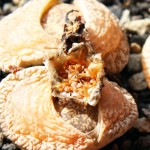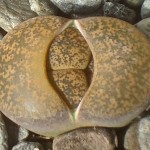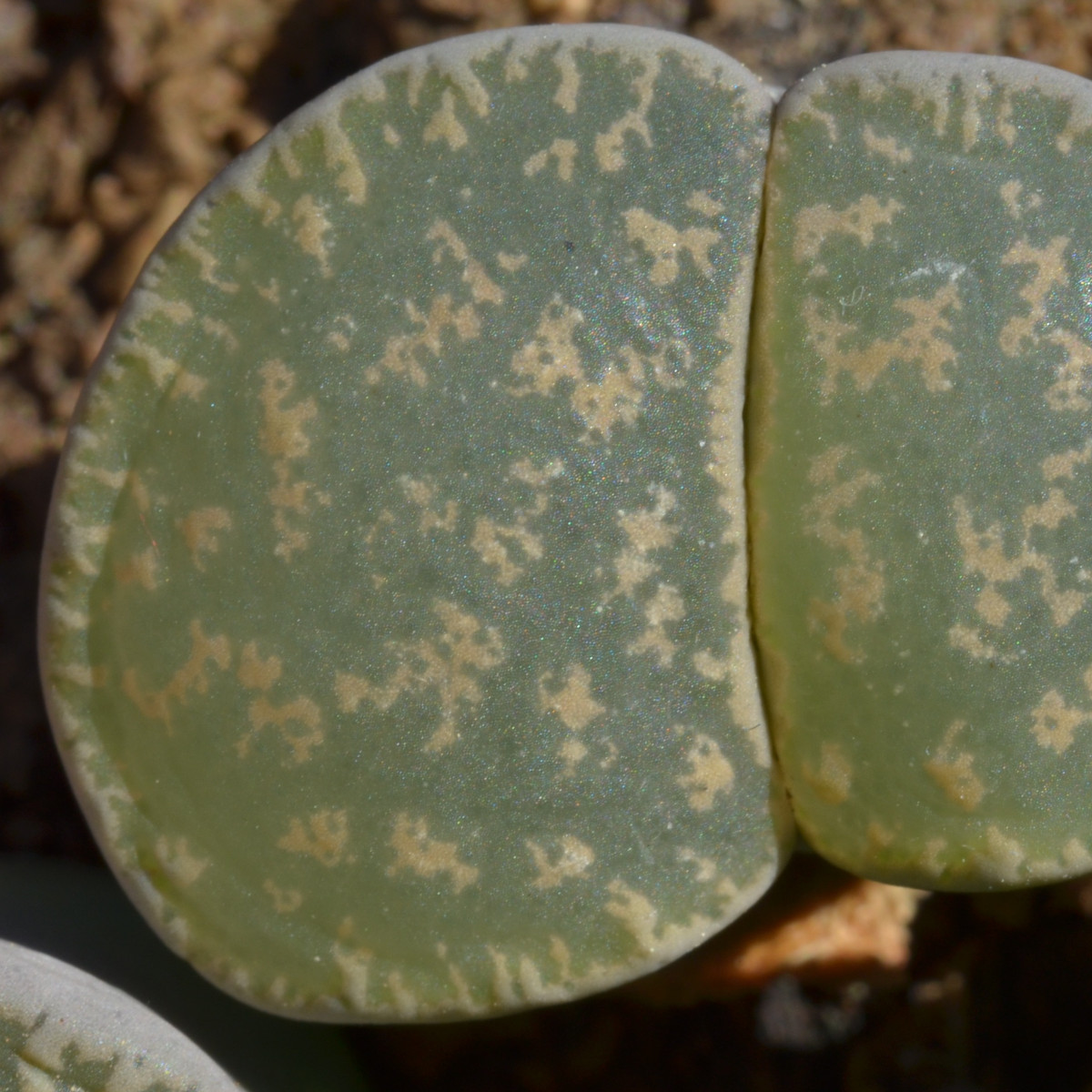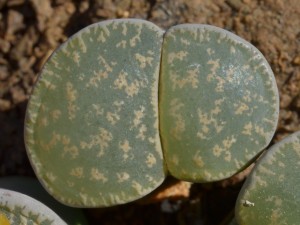Family: Aizoaceae
Synonymous: Lithops orpenii
Lithops venteri
Mesembryanthemum ferrugineum
Mesembryanthemum lesliei
Distribution and habitat: Lithops lesliei has just a provincial distribution in South Africa. The plant continues to be seen within its range, but this is as a threatened species of South Africa. It is found primarily in arid grasslands or savannas, usually in rocky places, growing under the protection of forbs and grasses.
Description: Lithops lesliei are resemblance to the stones among which they grow in their desert-like habitat. Each plant has a short underground stem that rise from a relatively long taproot. This buried stem carries a pair of thick and fleshy semi-circular leaves - which are identical in size, shape and colour - that are fused together for most of their length, a 5mm (0.2 inch) deep fissure. At the top of the line of fusion there is a slit or fissure, from which a single, daisy-like flower, 3cm (1 inch) wide, is produced in late summer are is golden yellow with pink shading on the underside of the petals. The upper surface of the leaves is flat-topped up to 4cm (1.5 inch) thick. Leaf colour is variable, running from pinkish gray to olive green with rust-coloured spots on the upper surface of the leaves. The leaf colour blend with its natural arid, rocky background.
Lithops lesliei are obligate outcrossers and require pollination from a separate plant. Their fruit is a dry capsule that opens when it becomes wet; in wild, some seeds may be ejected by falling raindrops and the capsule re-closes when it dries out. Capsules may also sometimes detach and be distributed intact or may disintegrate after several years.
After flowering, the old leaves gradually wither and dry up as a new pair emerges to replace them from the fissure between the two leaves.
Lithops lesliei form clumps, but it may take years to produce two or three pairs of low-lying leaves.
Houseplant care: Lithops lesliei is easy to grow, it tolerates a degree of excess water better than some particular hydrophobic species. Even so, it must have a very open mineral, fast draining potting mixture.
Light: Give these plants at least three or four hours a day of direct sunlight all year long. Care should be taken about exposing them to the full blast of the sun rays in summer. Such tiny plants can easily get scorched or broiled and their appearance spoiled.
Temperature: Normal room temperatures are suitable for Lithops lesliei. It can tolerate temperatures down to freezing, but should not generally be subjected to temperatures below 10C (50F).
Water: Water sparingly from late spring until the flower dies in the autumn, giving just enough to make the potting mixture barely moist and let the top two-thirds of the mixture dry out between waterings. From autumn to spring these plants have a rest period, during which new leaves replace the old ones.
During the rest period the water in the old leaves supplies the needs of the new leaves; give plants no more water until the following season. Start watering after the old leaves completely dry.
Fertilising: It is not necessary to feed these plants at any time.
Potting and repotting: Use an equal mixture of soil-based potting mixture and coarse sand or perlite. For good drainage put 2-3cm (0.8-1 inch) deep layer of clay-pot fragments in the bottom of the pot. Use a standard depth pot. A shallow pan may appear to be more than suitable for the low top growth, but it will not be deep enough for the searching taproot. Even though Lithops lesliei are clump-forming, the clumps form so slowly that the potting mixture provides nourishment for a long time.
Plant normally need to be moved on only when they begin to crowd each other in the pot - usually about once every three or four years.
Propagation: Divide overcrowded clumps in early summer. Keep a newly divided Lithops lesliei in bright filtered light and water it sparingly. Withhold water during the rest period.
Move the plant into a position where it receives full sunlight in late spring, when it should be ready to flower.
Plants can also be grown from seed, but the seedling usually take several years to reach flowering size.
Problems: Nearly all problems occur as a result of overwatering and poor ventilation especially when weather conditions are dull and cool or very humid. If too much water is supplied the plants will grow out of character, bloat, split and rot. Keep them in small pots as solitary clumps or as colonies in large, shallow terracotta pans.
Notes: Different Lithops species are preferentially found in particular environments, usually restricted to a particular type of rock. Lithops have not naturalised outside to his natural distribution, South Africa.
Lithops are partly subterranean, with only the clear 'window' in each leaf tip exposed above soil. A type of optical system exists whereby a layer of apical tissue rich in calcium oxalate crystals acts as a filter to intense sunlight before it reaches the thin chlorophyllous layer below. They show a striking similarity to their background rocks and are difficult to detect when not in flower. Its soil-embedded, subterranean growth form also reduces the need for chemical defences against herbivores.
Uses:Lithops lesliei is suitable for growing in containers and for indoors growing.
It is drought-tolerant; thus this it is suitable for xeriscaping in areas within its hardiness zone.
SUMMARY:
CHARACTERISTICS:
Foliage variegated
Features flowers
Shape low growing
Height: under 15cm (6 inch)
Spacing: 7-15cm (3-6 inch)
PROPER CARE:
Watering in rest period sparingly
Watering in active growth period sparingly
Light direct
Temperature in rest period min 10C max 21C (50-70F)
Temperature in active growth period min 16C max 24C (61-75F)
Humidity low
Hardiness zone: 10a-11







